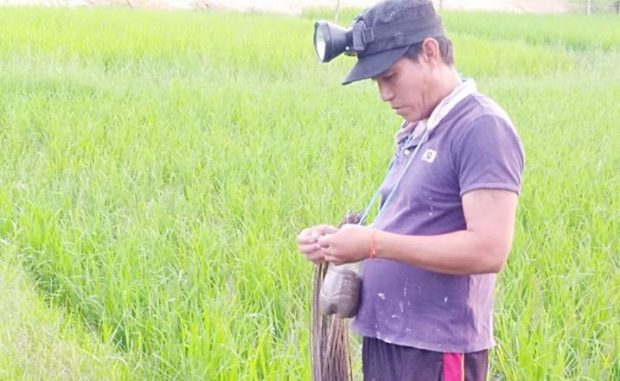Rice fields sprout fishing rods as villagers hunt frogs
VIENTIANE — There in the rice paddy fields, rows of rods and fishing lines hang over the shallow water with worms attached. They are still alive and flexing and seem to be very inviting to eat.
These rods can be seen throughout the rice fields in Vientiane, set there with the purpose of catching unsuspecting prey. But these traps have not been set for fish because the worms are not placed in the water. Instead they hang temptingly over the surface of water or mud.
In some places it looks as though not only rice is growing in the fields, as the rods sprout up in large numbers. The people of Nonwai village in Xaysettha district have set almost a thousand of these traps in the hope of catching something tasty.
One man who was preparing his fishing rods, named Mr Te, told me the rods were not for fishing but to catch frogs.
From this month until the end of Buddhist Lent, thousands of frogs will be hunted and caught, not just by people but by other animals.
Article continues after this advertisementThis is the season when frogs are traditionally hunted in large numbers as small armies of them swarm across fields and riverbanks. They are eaten and sold throughout the country, and are a popular addition to meal tables everywhere.
Article continues after this advertisementIn their normal habitat, frogs dig a cool burrow in the ground and eat almost any prey, including insects, snails, spiders, worms, and small fish.
Frogs catch insects with their long, sticky tongues. It takes less than a second for a frog’s tongue to roll out, catch its prey and roll back into its mouth.
Frog hunter Mr Te said the field where he set his rods was full of frogs jumping everywhere after emerging from nearby woods. They invade rice paddy fields in search of insects and small fish.
“Many people have about 100 fishing rods, but some have about 200 or 300 rods,” he said as he prepared his own for the night’s harvest.
“Many people grow rice here and also hunt frogs. Nowadays, they use fishing rods and batteries to deliver an electric shock so frogs are killed in their thousands but they are not extinct yet. There are still a lot of them around,” he said laughing.
But despite his assertion, where Nonwai village and other areas used to echo with the sound of croaking frogs at night, they can now sometimes hardly be heard as eager hunters stalk them with flashlights.
Mr Te said he sometimes invites his friends around at weekends to share the frogs they have caught. “My friends like to eat them, while drinking bottles of Lao whisky,” he said gleefully.
At this time of the year many people go to markets in Vientiane to buy frogs to add to soup, fry them in oil or grill them.
Nowadays markets not only sell wild frogs but also farmed frogs, while some people breed them in their backyards as a small business.
At present the frogs are not very big, but when farmers harvest their rice at the end of Buddhist Lent hunters will be happier because the frogs will have grown larger.
That is, if they survive until then. Of course, the biggest frogs are best for eating but they could all have disappeared by then as they are already being caught by the thousands.
Lots of people like to eat frogs caught in the wild and it’s important to check out specimens carefully before making a purchase, to determine whether they came from a paddy field or a farm.
Wild frogs cost more and vendors often lie and say frogs are wild when in fact they are not. The two types are similar in appearance. Sometimes they appear to be toads.
“I’m sorry, I’m catching fish, frogs and bullfrogs but not toads. I eat only frogs and bullfrogs, but never toads because their skin and eggs contain dangerous toxins,” Mr Te said.
“My wife doesn’t like them either because she says they eat smaller toads and frogs, as well as snakes and small mammals,” he added. So at least it seems the toad population is not in danger of extinction any time soon.
